 |
Stirling
N3640 - Barbon, near Kirkby Lonsdale
29th September 1940 |
Last
updated: 28.06.2018
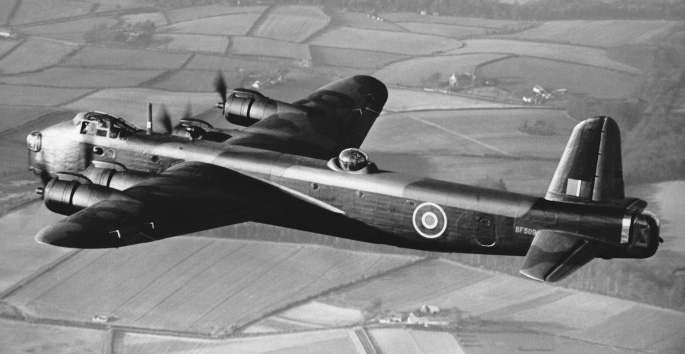
|
Short Stirling Mk.1
|
| Type |
Serial |
Unit |
Base |
Duty |
Crew |
| Stirling Mk. 1 |
N3640 |
No. 7 Squadron |
RAF Leeming |
Cross country practice flight |
7 |
The aircraft involved was a Short
Stirling Mk.1, ordered under contract 763825/38 and assembled by Short
Bros Ltd at Rochester. Taken on charge by No.7 Squadron on 3rd August
1940, it was first of its type to enter squadron service and also the
type's first operational loss. It was declared ‘Category W’ [write-off]
following a flying accident on 29th September 1940, with Bristol
Hercules II engine No.’s 126180, 127552, 127546 & 127608 also
declared ‘Category W’. The cause given for its loss was engine failure,
during a cross-country flight from RAF Leeming to assess fuel
consumption, which resulted in the aircraft force landing with the
undercarriage retracted. After touching down the aircraft ran through a
stone wall and came to rest in the next field, with the crew sustaining
minor injuries. There has been some confusion over this loss, after one
source (W.R. Chorley RAF Bomber Command losses, Vol.1)
suggested that the engine failure was the result of "friendly fire"
when an anti-aircraft battery on the Isle of Man opened fire on the
Stirling, damaging two engines - unfortunately this version of events
then went on to be repeated, apperently unchecked, in
several subsequent written works. However, there does not appear to be
any primary source material to suport this version of events and it is
not mentioned, either in the Squadron's records (ORB) or the loss
record card (Form 1180), so can be confidently discounted and is only
mentioned here for clarification.
| Name |
Age |
Position |
Fate |
| Flying Officer Terence Patrick Armstrong Bradley (DFC) |
23 |
Pilot |
I. |
| Sergeant R. Jackson |
|
|
I. |
| Sergeant A.A. Griffin |
|
|
I. |
| Pilot Officer J.W. Murray | | | I. |
| Sergeant A.C. Nicholson | | | I. |
| Sergeant E.L. Roberts | | | I. |
| Aircraftman 2nd Class J.F. Woods | | | I. |
The
wall that the aircraft collided with was in fact not just a field
boundary, but actaully a substantial retaining wall, reinforcing an
apparent ancient riverbank and meaning that there is a significant
height difference of several feet between the two fields. When
the aircraft came through this it would have dropped quite
suddenly and eyewitness reports suggest this broke the aircraft's back
and brought it to a sudden halt. The wall was later repaired by army
engineers using a concrete consolidation layer which means the repaired
section is still clearly visible to this day.
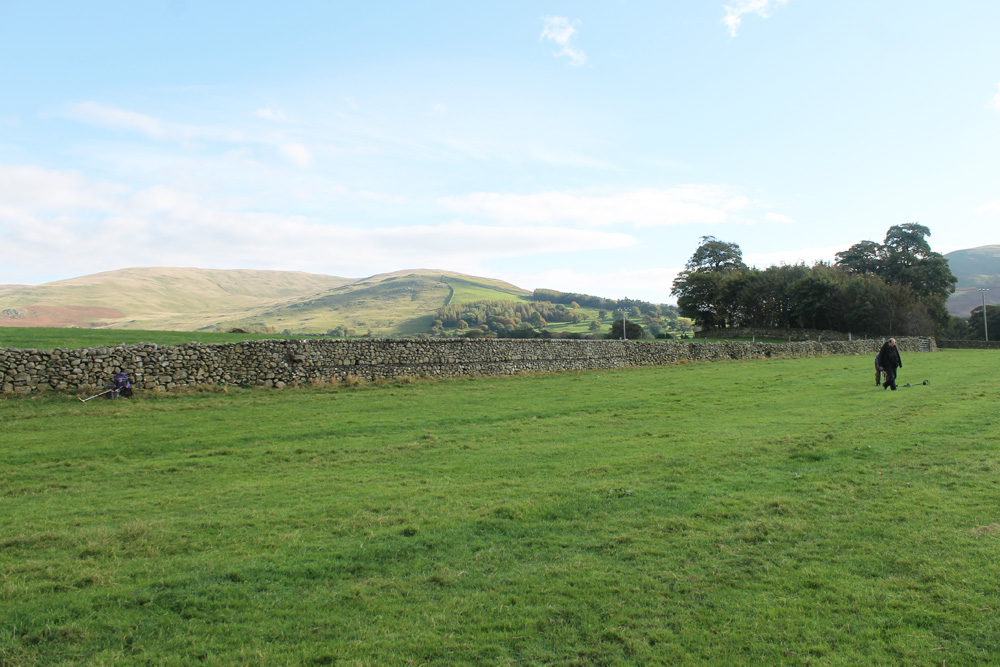
|
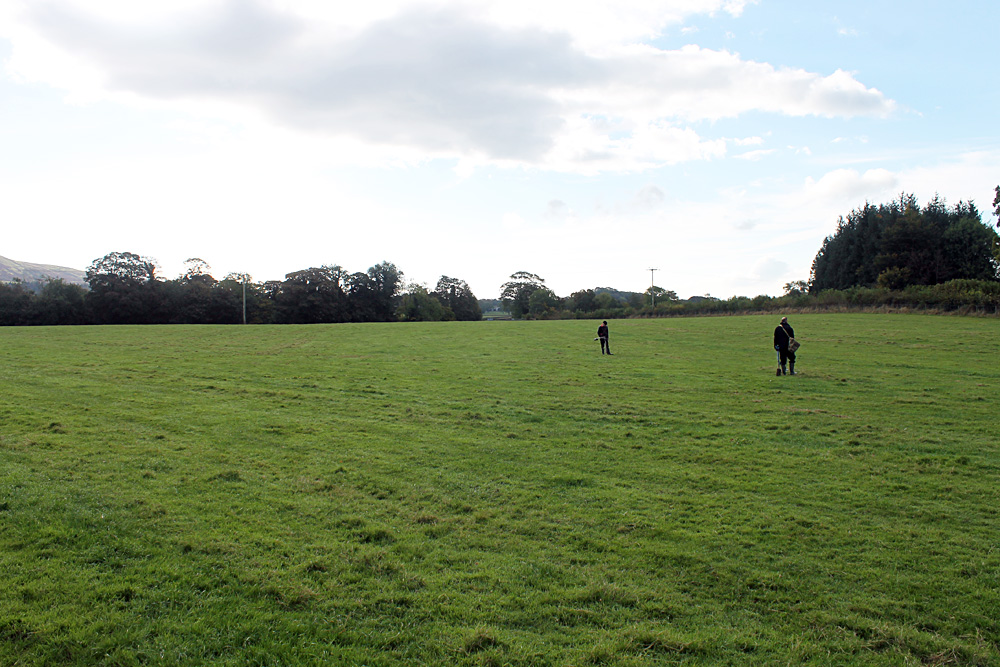
|
| The wall
demolished by the Stirling as it slid across the fields -
repaired section is clearly visible due to repair work utilising
concrete to stabilise the new section of wall. |
Lower field in which
Stirling N3640 came to rest - numerous broken .303 cases and bullets
were found in the area between the two figures, indicating that a
turret was probably badly damaged. |
Our
survey
of the crash site was carried out with the permission of the landowner
and we soon found that the ground was very hard and stony, with
relatively little topsoil, particulalrly in the upper field where the
aircraft first touched down. This meant that very few fragments from
the aircraft had peneterated the ground in this field, making it quite
difficult to follow its path. The few finds did however, appear to
indicate a path from the top left hand corner (standing with the
damaged wall to our backs) and perhaps even to another field beyond.
The aircarft then seems to have stopped abruptly after coming through
the wall with fragments being surprisingly localised and with badly
corroded and broken .303 ammunition being the most frequent find. All
finds were logged and GPS coordinades recorded, with any viable
ammunition being suitably disposed of.
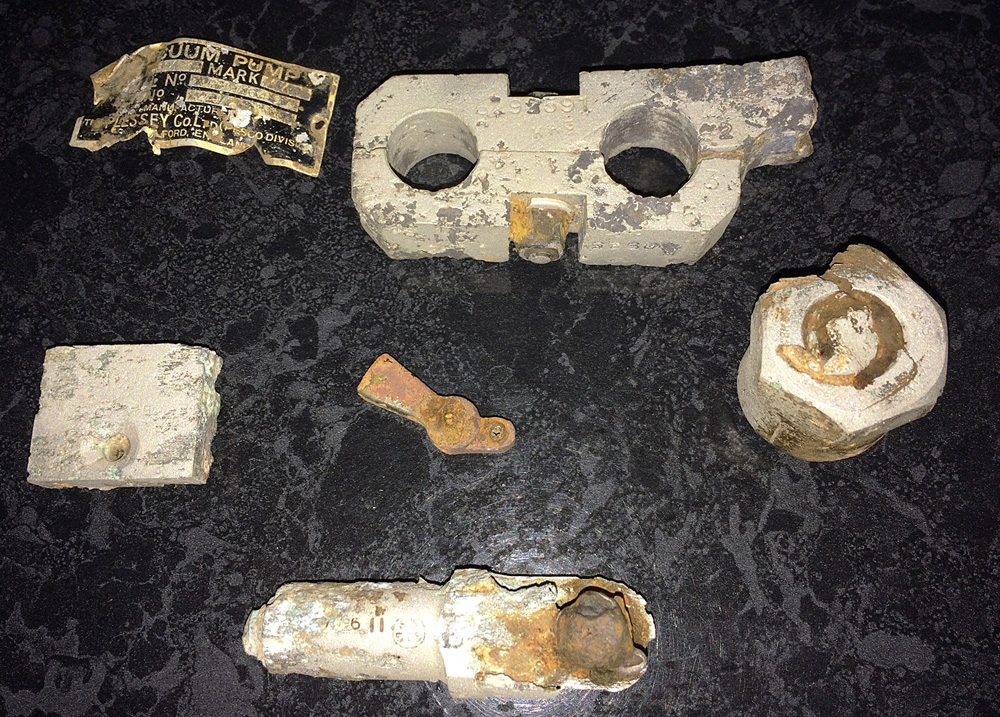
| 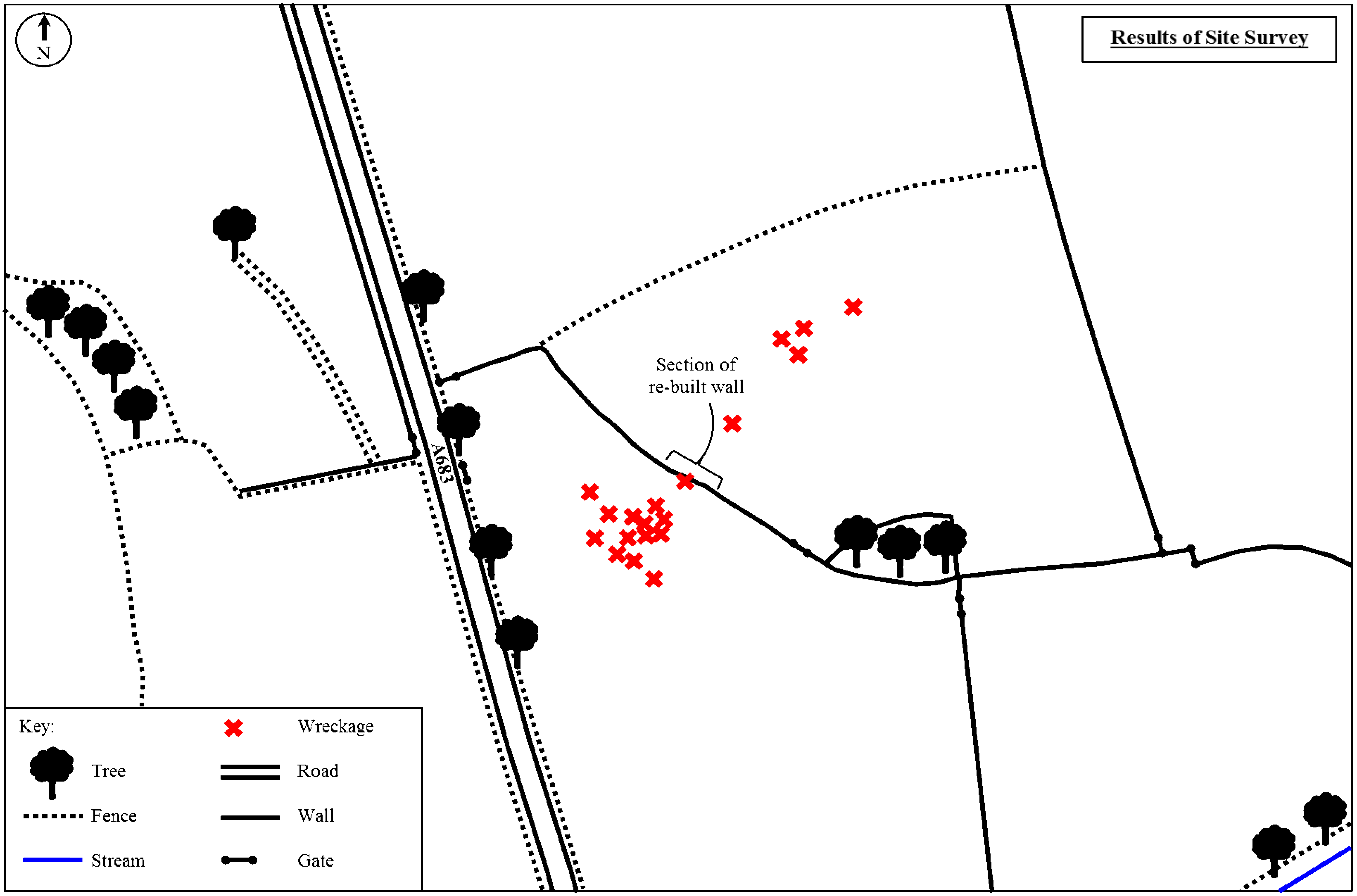 |
| Vacuum Pump
maker's plate, pipe clamps and pipe and control rod fittings, most with
SB (Short Bros.) maker's marks, with a toggle from a Type 5C/543 panel
switch to the centre | Map of crash site, showing find distribution of artefats associated with the aircraft. |
Additional Information:
Sergeant
A.A. Griffin had been injured in the crash of Armstrong Whitworth
Whitley K8984 in eastern France on 27th October 1939 whilst serving as
an Air Gunner with No. 51 Squadron. He was also apperently more
seriously injured in the crash of Stirling N3640 than records indicate,
with a relative stating that he recieved a broken leg, with a compound
fracture and was taken off front line duties. This injury later led to
complications ultimately resulting in amputation.
Flying
Officer Bradley was killed on the 10th April 1945 while serving with
No.27 Squadron, having been promoted to the rank of Wing Commander.
Acknowledgements:
John Barnes, Mark Sheldon, Dave Parkin, Gareth Brown
References:
1 – Air Ministry Form 1180 – Flying Accident Card for Stirling N3640 on 29th September 1940 (RAF Museum)
2 – Operations Record Book for No.7 Squadron (The National Archives – File Ref:AIR 27/98/1)
3 – The Stirling File (Revised Edition), by B. Gomersall (Air Britain - ISBN 0-85130-152-5)
4 – Royal Air Force Bomber Command Losses Vol.1, by W. Chorley (Ian Allen Ltd - ISBN 9781906537401)
5 – RAF Commands.Com forum - Thread title: Stirling shot down 18 August 1940 (archived 2012)
This page & all articles on this site
Copyright © Nick Wotherspoon 2018






